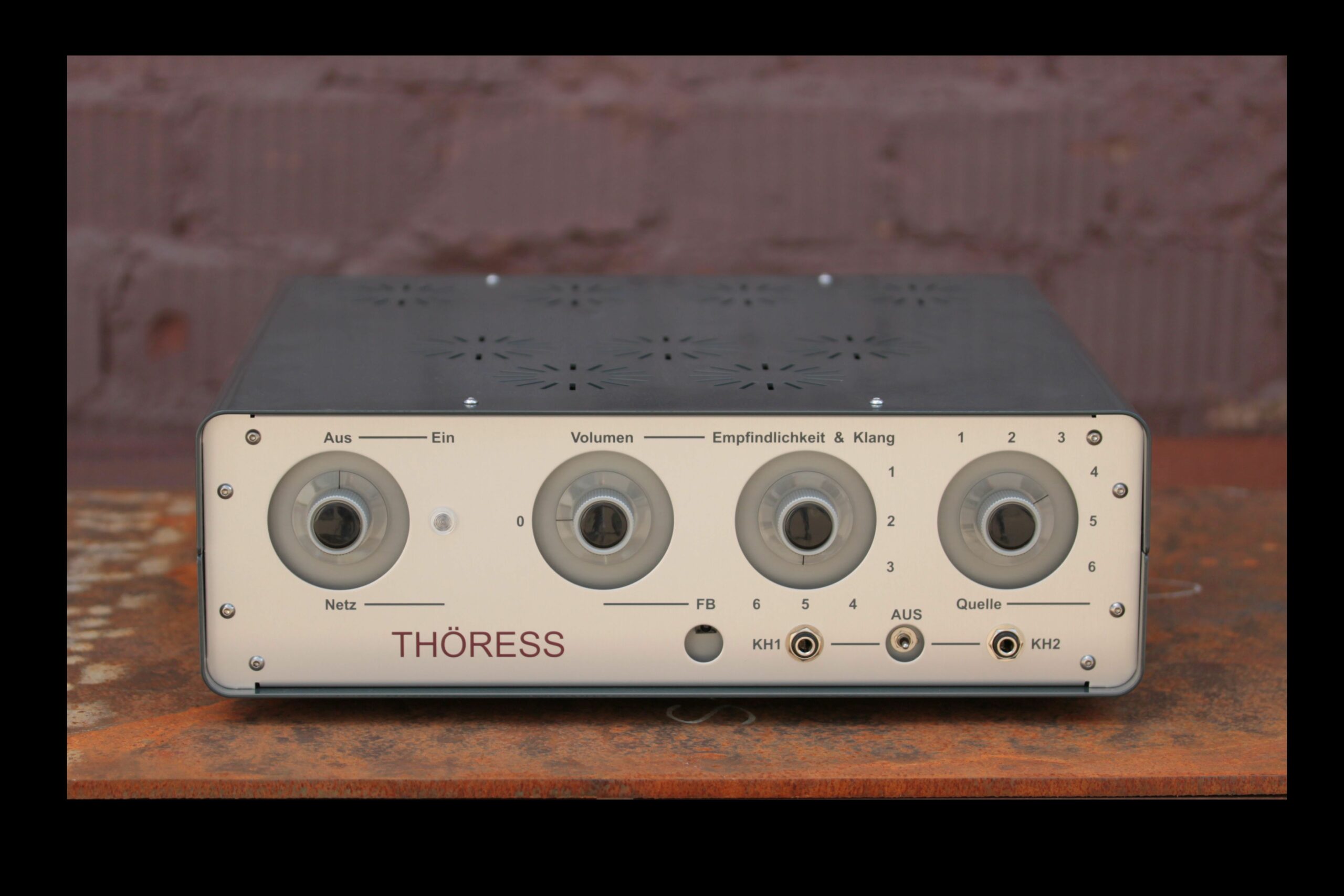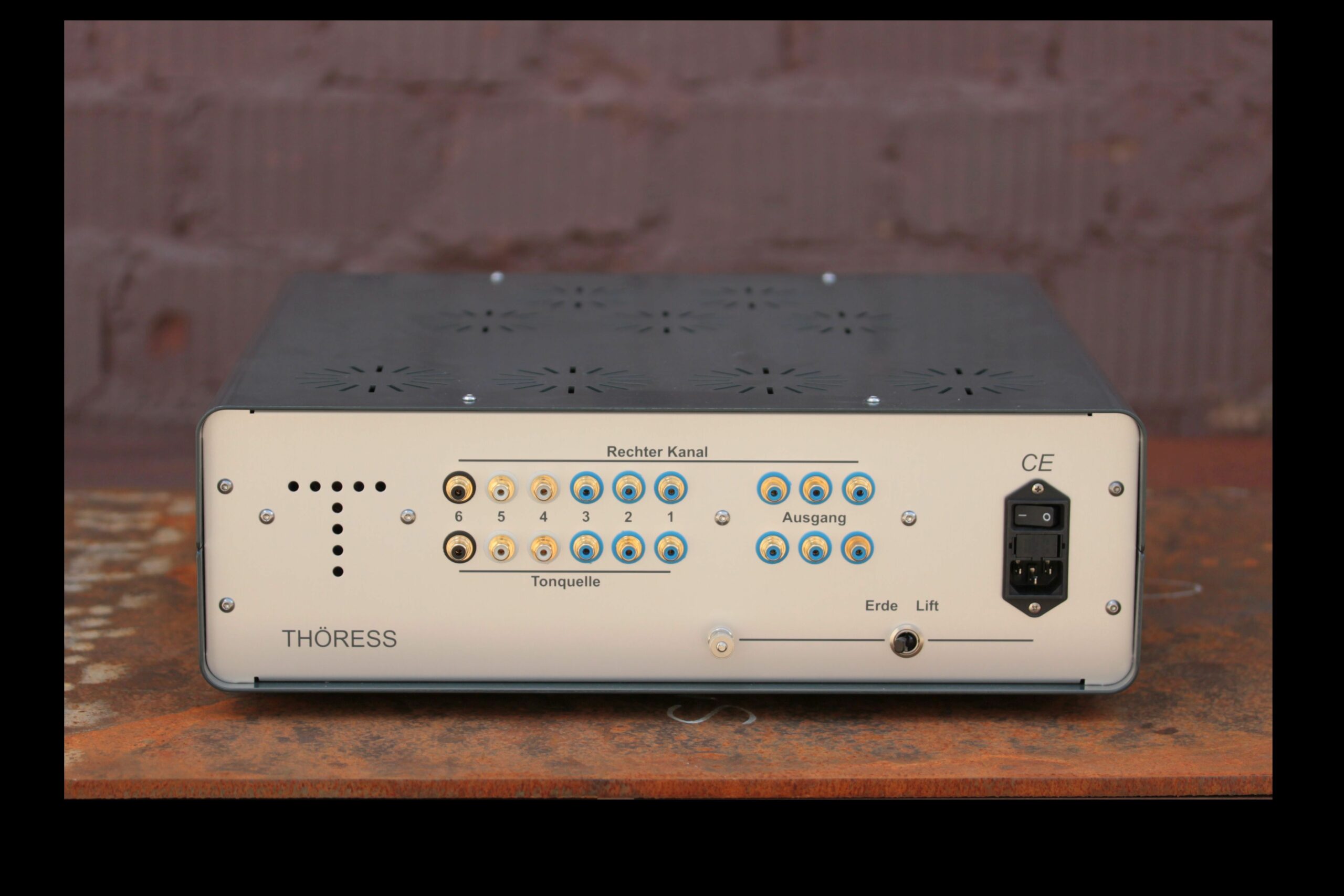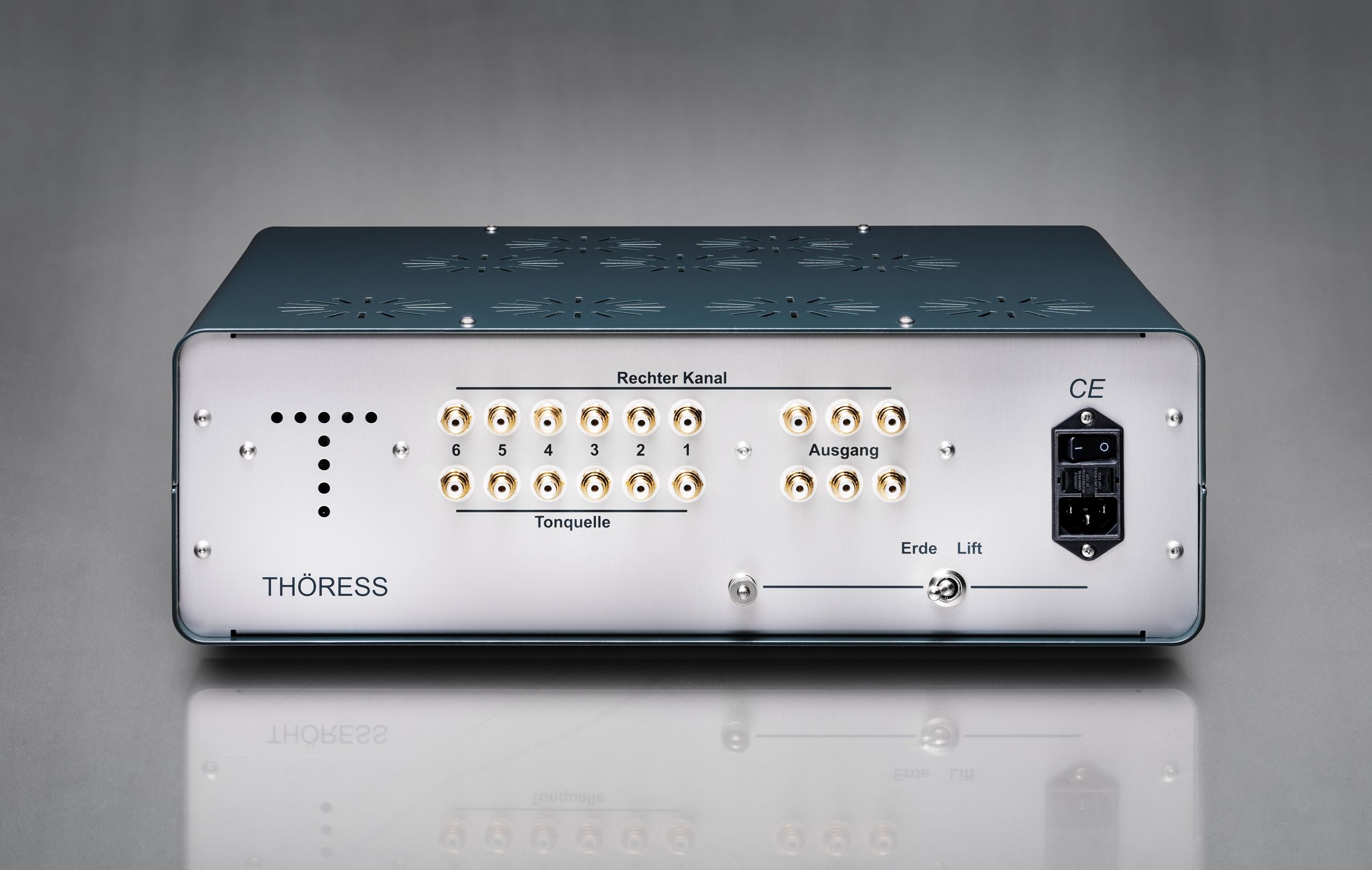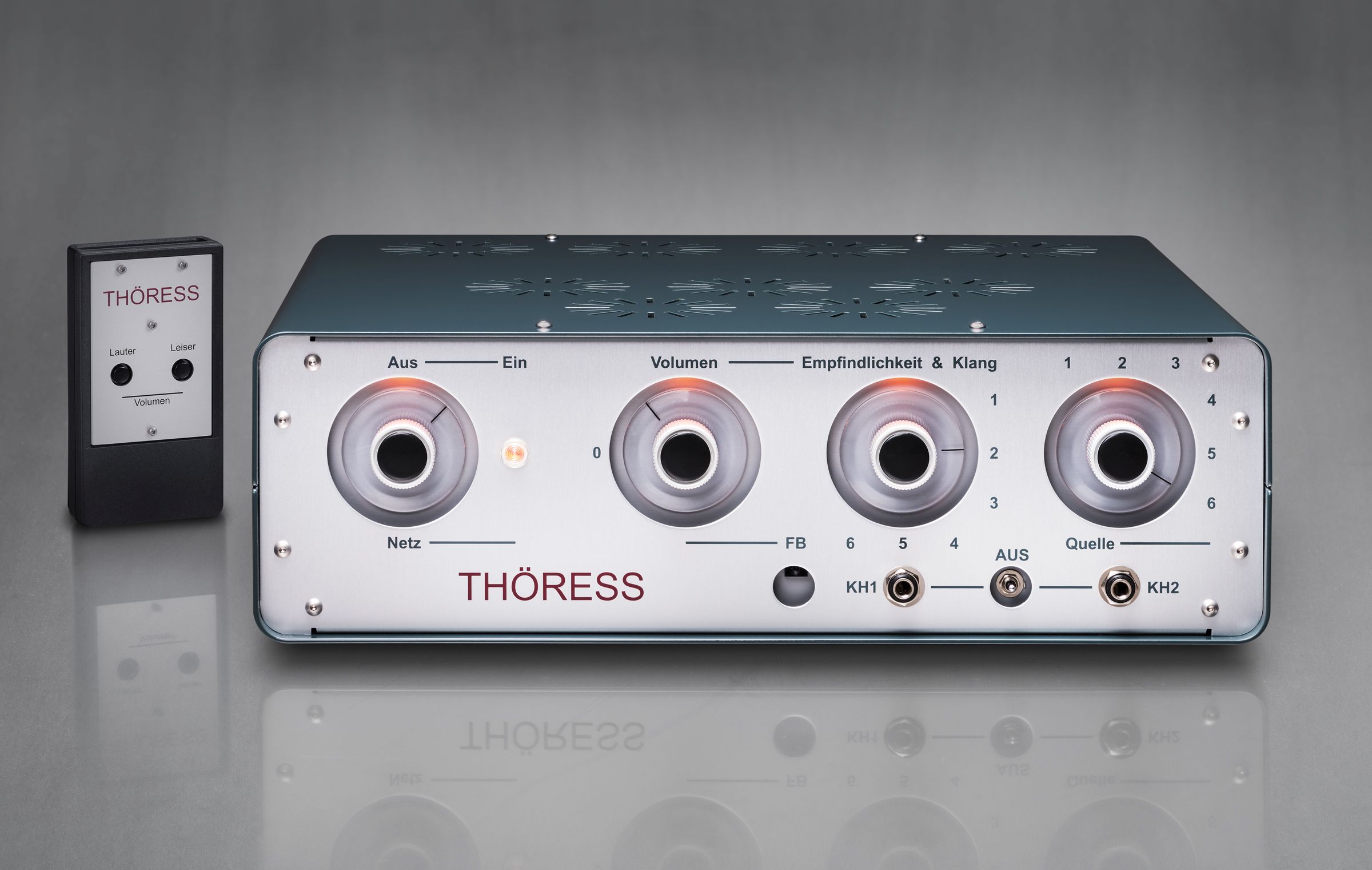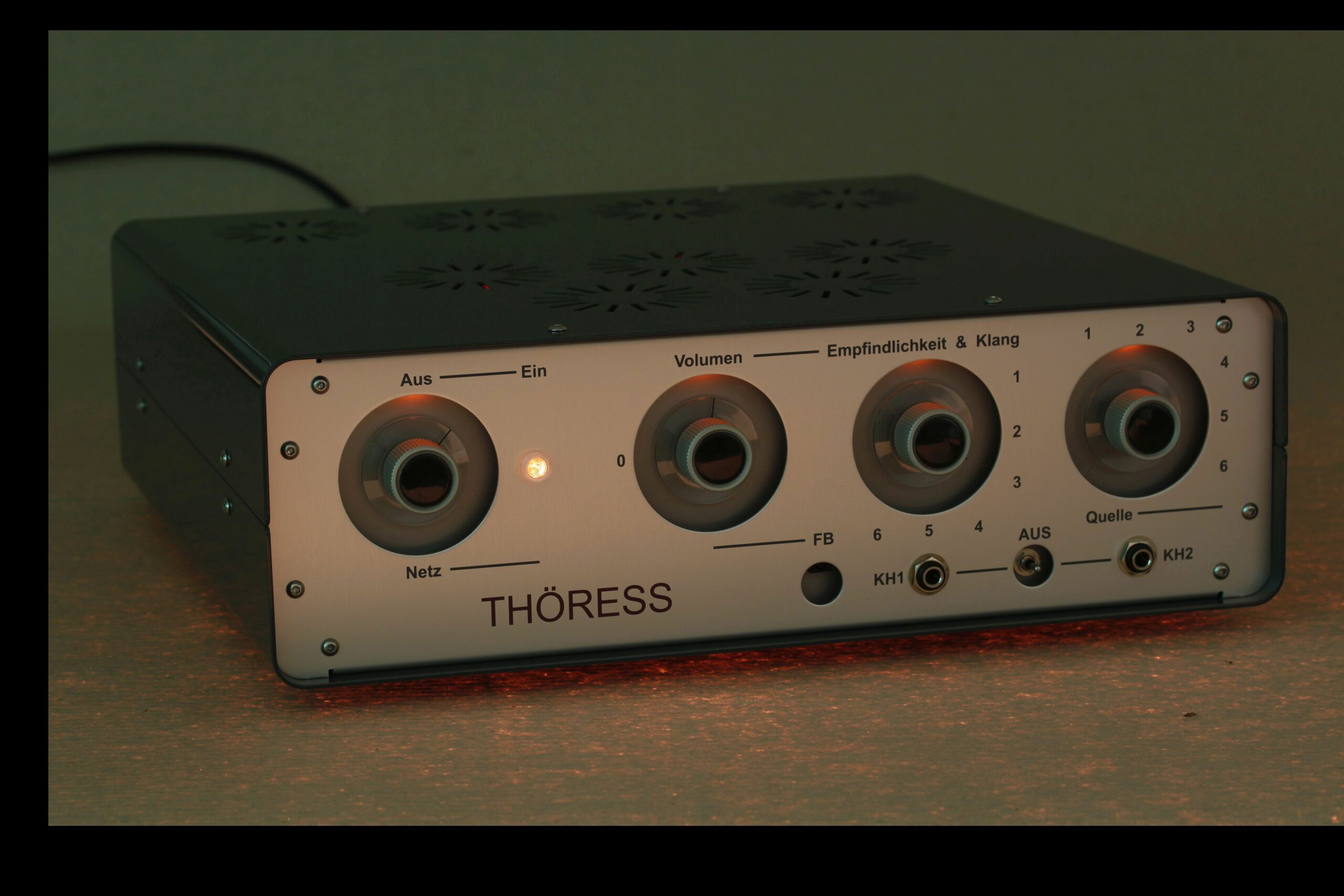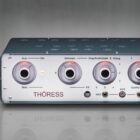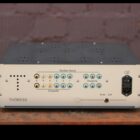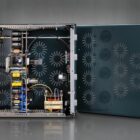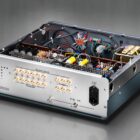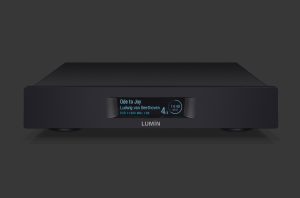Beskrivelse
An ultimate implementation of a line control amplifier and a headphone amplifier, both of which functions are performed by the same minimalist vacuum tube circuit with very low output impedance. Such providing the amplifier with an outstanding ability to simultaneously drive long cable runs and headphones with an impedance as low as 50 ohms or even lower.
The DFAmp also features unique tone control facilities and a custom designed remote volume control presented with typical THÖRESS style and attention to detail. The circuit of the amplifier consists of a triode gain stage followed by a unity-gain current buffer employing a power pentode operated in triode mode with high idle current.
GT SELECTOR
The DFAmp allows for subtle tonal manipulations via four on-the-fly selectable tone control presets (timbre registers) on two different gain levels implemented by means of a 6-position rotary switch which we call GT Selector (EMPFINDLICHKEIT & KLANG, G.AIN and T.ONE, GT).
Two positions of the GT selector are assigned with neutral tonality (flat frequency response). The mapping between selector positions, gain and sound effects is described by the chart below.
pos1: (-)6dB gain, bass boost style-3 and treble boost > B(+++)/TR(++).
pos2: (-)6dB gain, treble boost > B0/TR(+).
pos3: (-)6dB gain, NEUTRAL > B0/TR0.
pos4: full gain, bass boost style-2 > B(++)TR0.
pos5: full gain, bass boost style-1 > B(+)/TR0.
pos6: full gain, NEUTRAL > B0/TR0.
The timbre registers are useful for restoring tonal imperfections of the listening program (often given by a lack of extension on one or both ends of the audio band) and for equalizing the response of individual headphones by adding bass and/or treble extension to a given component.
The function assigned with pos1 of the TG selector can also be used for counteracting the so called loudness effect (weaker perception of bass and treble frequencies of humans at lower loudness). In practice, a combination of all three equalizing purposes will likely be simultaneously applicable.
Notably, the timbre registers act in a much more subtle way than common bass-andtreble tone control facilities and do not rely on conventional clumsy and sound destructive tone control circuitry. Each register is realized by interposing solely one additional capacitor (per register and channel) to the neutral mode circuit!
The THÖRESS Dual Function Amplifier (DFAmp) represents an ultimate implementation of a line control amplifier and a headphone driving amplifier. Both functions are performed by the same minimalist vacuum tube circuit with very low output impedance. This provides the amplifier with an outstanding ability to simultaneously drive long cable runs and headphones with an impedance as low as 50 ohms or even lower. The DFAmp features unique tone control facilities (timbre registers) and a custom designed remote volume control presented with typical THÖRESS style and attention to detail. The amplifier is entirely based on SINGLE-ENDED ZERO-FEEDBACK schematics. Decidedly ignoring the fact that many music lovers persistently believe in the myth that balanced technology (and the associated cable configuration with XLR connectors) is generally superior over single-ended concepts. Readers who want to learn more about our view on balanced techniques and our general design approach are encouraged to read the paper (THÖRESS – Behind the Curtain) available on request. In view of our commitment to single-ended design principles, the exclusive use of RCA jacks for signal input and output was obligatory. The circuit of the DFAmp consists of a triode gain stage (12J5GT or 6J5GT tube) followed by a unity-gain current buffer employing a 12GN7 power pentode operated in triode mode with high idle current. The 12J5GT/6J5GT tube is a medium-gain octal base triode with fairly low transconductance from the early times of tube electronics, whereas the 12GN7 is a rather modern (all-glass) high transconductance power tube with high gain capabilities, making it an ideal choice for buffer applications. Both tubes are unarguably among the most linear amplification devices ever developed in the history of electronic technology and as such are a perfect choice in the context of minimalist zero-feedback circuit design. The DFAmp, is built with meticulous hand construction using our proven point-topoint wiring techniques. Much care has been taken in arranging each aspect of the internal construction to ensure the highest reliability, low noise performance andease of service for many years to come. It is an ultimate component and as such a worthy complement to our Parametric Phono Equalizer and our all-tube or EHT based mono amplifiers. The sonic presentation of the amplifier is of utmost refinement in line and headphone driving mode and thus will easily measure up to the highest expectations of every discerning music lover. GT SELECTOR The DFAmp allows for subtle tonal manipulations via four on-the-fly selectable tone control presets (timbre registers) on two different gain levels implemented by means of a 6-position rotary switch which we call GT Selector (EMPFINDLICHKEIT & KLANG, G.AIN and T.ONE, GT). Two positions of the GT selector are assigned with neutral tonality (flat frequency response). The mapping between selector positions, gain and sound effects is described by the chart below. pos1: (-)6dB gain, bass boost style-3 and treble boost > B(+++)/TR(++). pos2: (-)6dB gain, treble boost > B0/TR(+). pos3: (-)6dB gain, NEUTRAL > B0/TR0. pos4: full gain, bass boost style-2 > B(++)TR0. pos5: full gain, bass boost style-1 > B(+)/TR0. pos6: full gain, NEUTRAL > B0/TR0. The timbre registers are useful for restoring tonal imperfections of the listening program (often given by a lack of extension on one or both ends of the audio band) and for equalizing the response of individual headphones by adding bass and/or treble extension to a given component. The function assigned with pos1 of the TG selector can also be used for counteracting the so called loudness effect (weaker perception of bass and treble frequencies of humans at lower loudness). In practice, a combination of all three equalizing purposes will likely be simultaneously applicable. Notably, the timbre registers act in a much more subtle way than common bass-andtreble tone control facilities and do not rely on conventional clumsy and sound destructive tone control circuitry. Each register is realized by interposing solely one additional capacitor (per register and channel) to the neutral mode circuit! INPUTS AND VOLUME CONTROL The DFAmp provides 6 inputs divided in 3 groups with different gain and impedance characteristics as described below. High Line Gain The gain on inputs #1, #2 and #3 is 26dB (20-times) with GT selector in pos4, pos5 orpos6 and 20dB (10-times) for all other positions (pos1/2/3). These 3 inputs present a comparatively high input impedance of 80.000 ohms to the connected program source and are in the first row suitable for classic line level sources such as phono preamplifiers, tuners and tape machines. Medium Line Gain Inputs #4 and ##5 are appropriate for medium output program sources such as CD and DVD players, streamers or stand-alone DACs offering 18dB gain (8-times, 18dB=26dB-8dB) with GT selector in pos4, pos5 or pos6 and 12dB (4-times, 12dB=18dB-6dB) for the other positions (pos1/2/3). The input impedance on these two inputs is 30.000 ohms. Low Line Gain Input #6 (input impedance 30.000 ohms) is assigned with an exceptionally low gain of 10dB (3-times, 10dB=26dB-16dB) with GT selector in pos4, pos5 or pos6 and 4dB (3-times) for all other positions (pos1/2/3). It is reserved for sources with exceptionally high output characteristic as they are found on some CD players and DACs with vacuum tube output configuration. The low-gain input can also be used for enhancing the impact of the timbre registers as explained in the manual of the DFAmp. Summarizing, the gain pattern on the inputs is (26, 26, 26; 18, 18; 10) dB and (20, 20, 20; 12, 12; 4) dB on standard units with GT selector in pos4, pos5 or pos6 and pos1, pos2 or pos3 respectively. Alternative gain patterns can be easily implemented on customized units on demand. Input selection is implemented in the most basic way by means of a rotary switch mounted on the rear panel near the input jacks driven by a front knob via extension shaft. A high grade motor-driven dual-potentiometer is employed for (remote or manual) volume control. These parts are made to our specifications by ALPS in Japan for low angle sensitivity in view of conveniently fine volume adjustment. Each individual potentiometer is selected from a large production batch for exceptionally good channel balance by careful measurement (0.3dB tolerance). OUTPUTS The L+R outputs of the circuit are simultaneously connected to paralleled 2×3 RCA jacks (on the rear panel) and a frontal 3-step toggle switch which feeds two adjacent headphone outputs KH1 and KH2 (2×6.35mm jack sockets). The line outputs are connected to the circuit permanently whereas the headphone outputs can be disengaged by setting the toggle switch to the middle position.MAINS TRANSFORMER The DFAmp is equipped with a proprietary mains transformer produced in-house to ensure the highest possible quality. This part has been specifically designed for low body noise emission and low leakage. Nevertheless, it is mounted to the chassis via isolation elements in order to eliminate even the slightest interference of residual transformer vibrations with the circuit. Since the mains transformer is produced inhouse we can easily built transformers for all kinds of mains voltages on demand, for example for 100Vac (Japan), 220Vac (South-Korea, China, Thailand, Indonesia) or 245Vac (Australia). F E A T U R E O V E R V I E W •Vacuum tube line control and headphone driving amplifier. •Both functions performed by the same unique minimalist single-ended zerofeedback circuit utilizing 2x12J5GT+2x12GN7 or 2x6J5GT+2x12GN7 tubes. •6x line level inputs, 3x26dB + 2x18dB + 1x10dB gain (2×6 RCA jacks). •3x paralleled master outputs with very low output resistance (2×3 RCA jacks). •2x toggle-selectable headphone outputs (2×6.35mm jack sockets). •Remote volume control via motor-driven dual-potentiometer with excellent channel balance and low angle sensitivity for conveniently fine volume adjustment. •Four on-the-fly selectable tone control presets entangled with a 6dB gain attenuator implemented via 6-position rotary dial (GT selector). •Full hand construction, point-to-point wiring throughout. •Ultra low noise and low leakage mains transformer manufactured in-house for 230Vac (115Vac via jumper setting), 100Vac (Japan), 120Vac (USA, Canada), 220Vac (South Korea, China, Thailand, Indonesia), 240Vac (UK) or 245 Vac (Australia). •Nonmagnetic aluminum casework, front and rear panel with anodized printing, powder coated lids, dimensions: 434x434xH154mm, 154=134+20/footers. •Dimensions of the crate: 650x650x350 mm. Shipping weight 11.7Kg.

